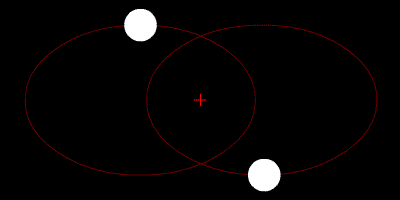Saturday, October 20, 2012
Planet with four suns – can they do astronomy there?
A discovery of a planet with four suns. It orbits one of a pair of stars and is in turn circled by a second pair. Also in the news this week, an Earth-like planet discovered around the nearest star to our own Sun.
But it's the planet with four suns that interests me more. A pair of stars is called a binary star, and here's a graphic. It shows the two stars orbiting around their common center of mass.
In this case we have two binary stars, so four stars in all. Imagine each dot is itself a binary star. The recently discovered planet is a gas giant orbiting one of the stars. It's been called PH1.
So four suns light up its skies.
Can they do astronomy?
Suppose beings inhabited this planet PH1. Which they can't as it's a gas giant, but lets suppose. Would they experience night? Perhaps never. Perhaps there would always be at least one sun in the sky. Imagining this to be so, can we speculate what sort of astronomy the inhabitants of PH1 can do? They would think the universe consisted of their planet and four suns. If there were one or more moons, they would be dimly aware of them perhaps, if on rare occasions they showed up in the perpetual daylight.
But the stars – these they would never see. Though the four suns might have numerous planets besides PH1, they would be unaware of these too. Unless, like Venus, a planet occasionally showed up in the daylight sky.
Or suppose the PH1 beings experience an occasional brief night when all four suns happen to line up on the other side of their world. What an amazing spectacle for them! Then they would briefly see the stars as pricks of light in a dark blanket and say to each other “what on PH1 is that?!”
But would the stars stay around long enough to prompt any investigation? That's the question I'm posing. Would they have time to notice that some of the stars behaved oddly and were planets?
Astronomy was born, I think, when sky watchers, having studied the heavens night after night, distinguished the wandering planets from the fixed stars, and charted the planets' courses. And it came of age when Copernicus realised that the Earth is itself a planet.
So astronomy on PH1 would be depressingly limited.
No night sky, no Copernicus
If they had a Ptolemy, he would devise a fearsomely complicated scheme of spheres and epicycles to account for the movements of the four suns. If they had a Copernicus he would propose it would be so much simpler to imagine the suns orbiting each other and their planet orbiting one of the suns.
But wait! … could they have a Copernicus? I don't think so.
First Copernicus (our Copernicus I mean) had to know about planets. Then he was able make the leap that the Earth itself is one. But a Copernicus on PH1 could know nothing of planets. So how could he make that leap.
No. I fear PH1 astronomy would stop with Ptolemy.
No Copernicus, no Galileo, no Newton, no Einstein.
Subscribe to:
Comments (Atom)

